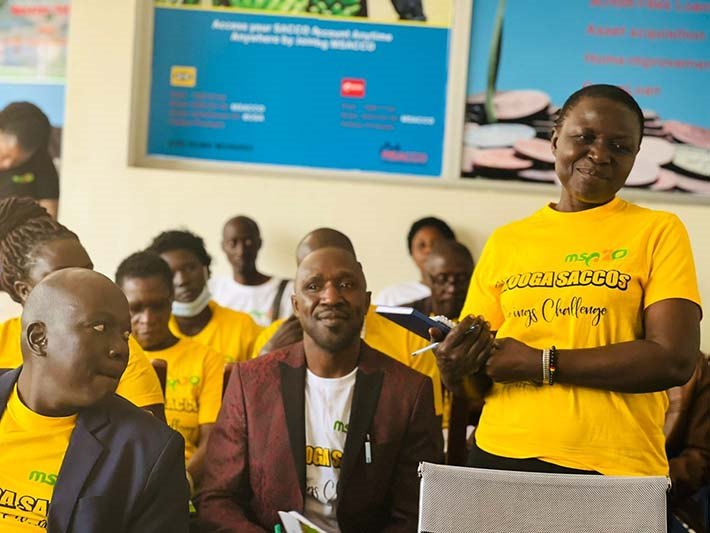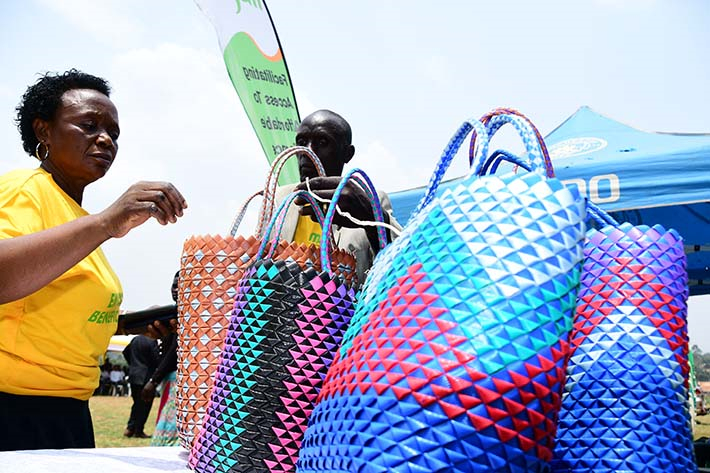|
||||||||||
| Home Nation World Business Opinion Lifestyle ChinAfrica Multimedia Columnists Documents Special Reports |
|
||||||||||
| Home Nation World Business Opinion Lifestyle ChinAfrica Multimedia Columnists Documents Special Reports |
| ChinAfrica |
| Lessons for Development |
| Uganda emulates Chinese experience by promoting local socio-economic growth from grassroots level |
| By Godfrey Olukya 丨VOL. 15 June 2023 ·2023-06-07 |

Leaders of Emyooga SACCOs from different parts of Uganda exchange ideas at the Busaiga SACCO in Fort Portal, west Uganda, on 11 January
After authorities in Uganda came to realise that the massive development in China came about after the authorities there organised local people to be productive right from village level, they took a leaf out of China’s book and came up with ideas of how this could work in Uganda.
President Yoweri Museveni said at a Labour Day celebration on 1 May 2018 that cottage industries in China had led to many people there creating wealth and that was one of the reasons why he came up with Emyooga programme.
“In Uganda, most of the toys, plates, cups, brushes, shoes, belts, caps, carpets, furniture and other items are imported from China and it is reported that they are made from cottage industries in the villages. That is what Ugandans want to do, with support from President Museveni,” said Milton Masembe, a commercial officer in the eastern town of Jinja.
Emyooga - financial assistance
Emyooga is a local language word meaning a “group of people doing the same thing.” Launched in August 2019, the programme is Museveni’s initiative on wealth and job creation as part of a broad government strategy targeting transformation of 68 percent of homesteads from subsistence to market oriented production, with the overall objective of promoting job creation and improving household incomes.
Ugandan Prime Minister Robinah Nabanjja said in an interview that Emyooga is meant to benefit all active Ugandans from the age of 18 and above. She said Emyooga is intended to support market vendors, welders, taxi drivers, carpenters, motorcycle taxis, women, performing artists, restaurant owners and other people who come together in the form of savings and credit cooperative societies.
While launching Emyooga, Museveni said that the ultimate objective of the Emyooga programme is to facilitate the socio-economic transformation of households from subsistence to the money economy and market-oriented production.
“Other objectives are to increase employment opportunities and also improve the household incomes of the target beneficiaries,” he said.
At the launch, Museveni instructed that people in villages form Savings and Credit Cooperative Organisations (SACCOs), through which they receive the money from the government for development.
Hajji Haruna Kasolo, minister of state for microfinance, said in an interview that the programme became effective in early 2022, and the government has set aside substantial funds to support local SACCOs.
“They are supposed to see that money [is used] in agriculture, business and other activities and [then] paid back in one year, so that other members [can] also get it,” said Kasolo. In 2020, government provided 140 billion shillings ($37.1 million), 170 billion shillings ($45.2 million) in 2021 and 260 billion shillings ($69.1 million) in 2022/2023.
Museveni said while speaking at Liberation Day celebrations on 26 January that there are 12,000 SACCOs in the country and so far, 90,000 of them have already received Emyooga money.
Among the beneficiaries of Emyooga is Stella Namazzi. Previously, she operated a small stall from where she sold tomatoes, cabbages, onions and other vegetables using a capital of 300,000 shillings ($79.52).
“My daily income was about 40,000 shillings ($10.6) with a net profit of about 5,000 shillings ($1.33). But when Emyooga was introduced, I borrowed 700,000 shillings ($185.56) and now I have a capital of 1 million shillings ($265) and my daily profits have increased to around 20,000 shillings ($5.3) daily,” said a very happy Namazzi.
She is a member of a SACCO called Bakazi Kwekulakulanya based in central Uganda’s Mityana District, through which she acquired the loan.
A single mother of three, she said, “Now I can ably pay school fees for my children, and I have bought a piece of land on which I am going to construct a house.”
Bob Mukwasi, a charcoal dealer, said that he used to buy only 40 bags of charcoal from collection points in surrounding villages; but after getting 900,000 shillings ($239.3) from Emyooga, he is now able to buy 70 bags of charcoal at each collection.
Meanwhile, Regina Namuli, whose retail shop closed during the COVID-19 pandemic, said that she got a loan of 500,000 shillings ($132.54) from Emyooga and was able to restock her shop.
“I thank the government for thinking about us and introducing Emyooga, from where we get money to support ourselves and our dependents,” she said.

A member of a tailors’ SACCO sells products in Bugangaizi, west Uganda, on 22 February
Parish development model
After realising that not all Ugandans can access money through the Emyooga initiative, the government came up with another programme called Parish Development Model (PDM).
Sub-counties of Uganda are divided into parishes, which are then further divided into villages.
PDM is a government strategy or approach for organising and delivering public and private sector interventions for wealth creation and employment generation at parish level, being the lowest economic planning unit. It is meant to ensure service delivery by improving incomes and welfare of all Ugandans at household level.
Unlike Emyooga, which targets individuals in SACCOs, the PDM involves larger amounts of money for people interested in establishing projects like cottage industries, farms or schools. Every year, each parish gets 100 million shillings ($26,507) to be shared equally among 100 people, which they use to either start up a cottage industry or use in agriculture projects. The money must then be paid back at 8 percent interest per annum within five years.
Museveni launched PDM on 26 February 2022 after which the money dispatched. At a ceremony held in the Uganda’s eastern district of Kibuku, Museveni said, “PDM is meant for Ugandans to join [the] money economy and encourage [an] increase [in] their demand for goods and services.”
He called on Ugandans who want to start up projects, or to improve on those they are already working on, to take advantage of PDM.
“If each district with dozens of parishes gets PDM money, each year, over 1 million Ugandans will get 1 million shillings each for development. This year, over 70 percent of the districts are expected to get the money budgeted for PDM,” he said.
In a special address to Parliament on PDM, he also issued a stern warning to anyone involved in fraud or theft in both the Emyooga and PDM initiatives that he would deal with them decisively.
According to Matia Kasaija, minister of finance, planning and economic development for Uganda, in this financial year a budget of 1.06 billion shillings ($265,079) was put in PDM.
Recipient James Oyet used his boss’ old motorcycle to operate as a motorcycle taxi. He said early in March that he received 1 million shillings ($265) from PDM. So, along with some of his own savings he was able to buy himself a new motorcycle. “I now own a motorcycle,” said Oyet.
Entrepreneur Kelly Mujaga, a carpenter, used to make 15 chairs a month because he had limited capital. After receiving his 1 million shillings he now plans to produce 30 chairs per month.
In the agricultural sector, Martha Akello said, “I had only five pigs; but after getting 1 million shillings from PDM, I expanded my piggery by buying 20 piglets.”
|
||||||||||||
| About Us | Contact Us | Advertise with Us | Subscribe |
| Copyright Beijing Review All rights reserved 京ICP备08005356号-5 京公网安备110102005860号 |